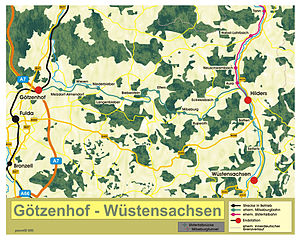Götzenhof – Wüstensachsen railway line
The Götzenhof – Wüstensachsen railway line , the sections of which from Götzenhof to Hilders were referred to as the Biebertal Railway , then also the Rhön Railway , was a single-track branch line in Hesse . It began at Götzenhof train station and ran through the districts of Hofbieber and Hilders to Wüstensachsen . In Hilders there was a possibility to change to the Ulstertalbahn .
| Götzenhof – Wüstensachsen | |||||||||||||||||||||||||||||||||||||||||||||||||||||||||||||||||||||||||||||||||||||||||||||||||||||||||||||
|---|---|---|---|---|---|---|---|---|---|---|---|---|---|---|---|---|---|---|---|---|---|---|---|---|---|---|---|---|---|---|---|---|---|---|---|---|---|---|---|---|---|---|---|---|---|---|---|---|---|---|---|---|---|---|---|---|---|---|---|---|---|---|---|---|---|---|---|---|---|---|---|---|---|---|---|---|---|---|---|---|---|---|---|---|---|---|---|---|---|---|---|---|---|---|---|---|---|---|---|---|---|---|---|---|---|---|---|---|---|
| Route number : | 3820 | ||||||||||||||||||||||||||||||||||||||||||||||||||||||||||||||||||||||||||||||||||||||||||||||||||||||||||||
| Course book range : | 506 (1986) , 190z (1944) | ||||||||||||||||||||||||||||||||||||||||||||||||||||||||||||||||||||||||||||||||||||||||||||||||||||||||||||
| Route length: | 35.3 km | ||||||||||||||||||||||||||||||||||||||||||||||||||||||||||||||||||||||||||||||||||||||||||||||||||||||||||||
| Gauge : | 1435 mm ( standard gauge ) | ||||||||||||||||||||||||||||||||||||||||||||||||||||||||||||||||||||||||||||||||||||||||||||||||||||||||||||
|
|||||||||||||||||||||||||||||||||||||||||||||||||||||||||||||||||||||||||||||||||||||||||||||||||||||||||||||
history
Construction and opening
In 1880 the Rhön Club founded an initiative to build railways so that the northern Rhön could be better developed. In 1885 the planning decision followed by the municipal parliament in Kassel. The law to build the Fulda – Hilders – Tann railway was enacted in 1886 by Kaiser Wilhelm I. Just three years later, on June 1, 1889, the Götzenhof – Bieberstein section was opened. Now the other sections followed and on December 12, 1890 the Bieberstein – Hilders section was ceremoniously opened. The Milseburg Tunnel was built between 1887 and 1889 in a two-year construction phase . With the opening of the section to Tann on June 1, 1891, the route was completed. After completion of the Ulstertalbahn Geisa – Tann, a connection between the Rhönbahn and the potash district in the Werra valley was created in 1909 .
The last section from Hilders to Wüstensachsen went into operation on February 1, 1916. The removal of lignite from Melperts and basalt from Seiferts were cited as building sites for the section planned as an extension of the Ulstertal Railway in 1907 . The lignite production in the St. Barbara shaft at Lettengraben near Wüstensachsen, for which a siding at Melperts was planned, was decisive in laying the route on the eastern bank of the Ulster. As the intersection with the Ulstertal Railway, Hilders station was expanded considerably. During the work on the railway line during the First World War, French prisoners of war were used.
Shutdown
Due to the constantly deteriorating condition of the track system, a passenger train from Hilders to Wüstensachsen drove for the last time on September 25, 1966, and this section was then operated as a replacement rail service. On March 1, 1970, the rail replacement service ended at the same time as the Seiferts – Wüstensachsen freight service. Then the track system was dismantled.
On September 27, 1986, passenger transport from Götzenhof to Hilders was stopped. Freight traffic continued until the end of 1992, the complete shutdown of the entire Götzenhof – Seiferts line took place on July 31, 1993. The tracks were dismantled in November 1995.
In 2003 the Milseburgradweg was built on the railway line from Götzenhof to Hilders .
The largest station on the route was Hilders station with eight switches and 450 m siding.
Vehicle use
In the early days of the railway, three to four pairs of passenger trains with goods transport ran daily, hauled by a T 9 class tank locomotive.
Due to the increased volume of traffic and complaints from travelers, later only pure passenger or freight trains drove.
From the 1950s onwards, passenger traffic was increasingly carried out, and later mainly with VT 98 rail buses , while freight trains were hauled by class V 100 diesel locomotives from the 1960s onwards .
literature
- Berthold Seliger: Rhönexpress on the siding . Fulda 1986.
Web links
Individual evidence
- ↑ Michael Knauf, Markus Schmidt: The history of the Ulstertal Railway 1981-1996; Verlag Rockstuhl, Bad Langensalza 2018, ISBN 978-395-966-295-6 , page 77ff.
- ↑ Michael Knauf, Markus Schmidt: The history of the Ulstertal Railway 1981-1996; Verlag Rockstuhl, Bad Langensalza 2018, ISBN 978-395-966-295-6 , page 238.


